Cite this document
(“The Financial Statements of Inditex and GAP Assignment”, n.d.)
The Financial Statements of Inditex and GAP Assignment. Retrieved from https://studentshare.org/finance-accounting/1770877-financial-statement
The Financial Statements of Inditex and GAP Assignment. Retrieved from https://studentshare.org/finance-accounting/1770877-financial-statement
(The Financial Statements of Inditex and GAP Assignment)
The Financial Statements of Inditex and GAP Assignment. https://studentshare.org/finance-accounting/1770877-financial-statement.
The Financial Statements of Inditex and GAP Assignment. https://studentshare.org/finance-accounting/1770877-financial-statement.
“The Financial Statements of Inditex and GAP Assignment”, n.d. https://studentshare.org/finance-accounting/1770877-financial-statement.


